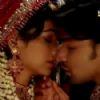Originally posted by: polly_03
honestly i never found any reference of Shobha in any historical book dat i hv read till date, so i really dont hv any idea abt her..i hv to depend on dis show & d info dey present us..on d contrary, i read dat Mahmud of Ghazni destroyed d Somnath Temple in 1026 & latr it was reconstructed by d king BhimDev Solanki ( PRC fans will remember him ) !!
Establishment of the dynasty
1.MULRAJA I960/995 or 942/997
2.CHAMUNDARAJA
|
3.VALLBARAJA
|
4.DURLABHARAJA ----- Unknown
1009/1021 |
5.BHIMA DEV I
| 1021/1063+
--------------------------
| |
7.SIDHRAJA JAISINH 6.KARNA I [Karan Dev I]
| 1063/1093
1093/1143+ |
|
8.KUMARAPALA ----- Unknown (Brother)
1143/1173 |
9.AJAVAPALA
|
--------------------------------
| |
11.BHIMA DEV II (killed nephew) Unknown (die while Ajavpal was alive)
| died 1242 |
12.TRIBUVANPAL 10.MULRAJA II
1242/1244
Mulrau
Mulraj (942–996) Solanki overthrew Samantsinh Chavda in 942 and set up what came to be known as the Solanki dynasty. Mulraj Solanki's father was Raji who probably ruled in Gurjaratra region around Jodhpur. Raji's marriage with Samantsinh Chavda's daughter does not have any bearing for invitation to Mulraj to take over Anhilvad pattan. Raji was a suba of king Mahipal Parihar of Kanyakubja. Raji seems to have related with king Mahipal by marrying his daughter. Losing his kingdom in attacks by Rashtrakut king Krishna III in 940, Mulraj moved southward from Gurjaratra region and took over Anhilvad Patan from Chavda rulers in 942. Mulraj was from Bhardwaj Gotra and Agnivanshi Kula. Mulraj married to Madhavi, a daughter of king Chauhan Bhoj. Initially, Mulraj's territory was around Siddhpur Patan. His son Chamund started taking responsibility during his ruling (977). He defeated Abhira king Grahripu of Saurashtra and Laxraj (Lakha Fulani) of Kutch. He snatched Lat for some period from Barapp in one war. Shakambhari king Vigrahraj Chauhan defeated Mulraj. He got defeat from Malav King Munj Parmar (Vakpati II).
After death of Munj in 995, Mulraj adorned self as "Param Bhattarak Maharajadhiraj Parmeshawara". His administration pattern was similar to Gupta's. He invited many learned Brahmins-Brambhatta and other castes to settle in Saraswat mandal. He bestow the land of Devasthali – Sidhapur to Brambhatta of Kanshi - Varanasi. Some Bram-Bhatta family are holding the same land in Devsthali. He constructed several temples. Also he initiated construction of Rudra Mahalaya in Siddhpur. He was kind hearted, brave, smart and shred in ruling his kingdom. Considering need of situation, he was accepting defeat to save his kingdom. He died in 996. At the time of his death, his kingdom included Saraswat and Satyapur Mandals, Kutch and some territories of Saurashtra. Mulraj Solanki's reign marked the start of a period during which Gujarati culture flowered as manifested in art, architecture, language and script. It is described as the golden period of Gujarat's chequered history. Mulraj himself adopted the title of Gurjaresh, an aristocratic title. The territory under the sway of the Solankis came to be known by different variations such as Gurjardesh, Gurjara-Rastra, Gurjaratra and finally Gujarat.
Chamund
Chamund (996–1009) could not extend his kingdom territory further. He tried to be independent from Malav king Sindhuraj (successor of Munj) but could not succeed. In the later years of his life, he lost his character (womanizer). His sister Chachinidevi dethroned him and gave it to his son Vallabhraj in 1009. Chamund ended his life by immersing in Narmada river near Shuklatirth.
Vallabhraj
Vallabhraj (1009 for six months) attacked King Sindhuraj's territory as soon as he became king. He died due to small pox in the war.
Durlabhraj
Durlabhraj (1009–1022) (brother of Vallabhraj) could not extend father's kingdom much. He married the sister of Chauhan Baliraj's son Mahendra of Naddul. He was of good character. He invited Jain saints in his kingdom. He continued as Samant of Malav king Bhoj. After his death, his nephew Bhimdev (son of Nagraj) became king in 1022.
Bhimdev I
Bhimdev I (1022–1063) was son of Durlabhraj's brother Nagraj . Bhimdev's mother was Laxmidevi, a princess of Chauhan of Naddul. Bhimdev was a mandlik of Malav king Bhoj. Sultan Mehmud of Gazani invaded Anhilpur pattan in December 1025. Bhimdev had to flee and take shelter in Kanthkot fort in Kutchh. In January 1026 Sultan Mehmud of Gazani attacked Somnath temple, demolished it completely. United army of all kings under leadership of King Bhoj chased Sultan Mehmud thereafter. He had to flee from the place to Gazani. Bhimdev was one of the foremost participant of the united army. Bhimdev and Bhoj jointly reconstructed Somnath temple. Bhimdev added Saurashtra, Kutchh, Abu and some parts of Khetak mandal and Mahimandals with his kingdom. Bhimdev became independent from Bhoj on his death in 1054. Bhimdev had married to Udaymati, a pricess of Saurastra Narvahan Khengar. He had also married to Bauladevi (also called Chauladevi) who was not a princess. Bhimdev had a son named Karndev from Udaymati and sons named Xemraj and Mulraj from Bauladevi. Mulraj died in very early age. Shantacharya and Suracharya were two Jain saints during his reign. Apart from reconstruction of Somnath, Delwada temples by Vimalshah, Modhera Sun Temple and Stepwell of Udaymati (Raniki vav) goes to Bhimdev's credit. Bhimdev died in 1064. Karndev (Bhimdev's son by Udaymati) came on the throne after Bhimdev's death.
Karndev
Karndev (1064–1094) (Bhimdev's son by Udaymati) came on the throne after Bhimdev's death. He is described as a very handsome king. As soon as he came to the throne, he made friendship with King Someshwar of Kalyani. Up to 1075, he added entire Lat in his kingdom. His territories were touching Konkan in south and Naddul in north. He married to Karnataka's king Tribhuvanmalla's friend Jaykeshi's daughter Mayanalladevi (Minaldevi). Jaykeshi was Konkan's suba. Karn had built many temples, lakes and cities like Karnavati. Shakambhari's king Dushshal chauhan defeated and killed Karn in a war. Malav king Laxmdev and Naddul king Joggal helped in defeating Karndev. Patan's condition was worse in the last days of Karandev. His son Jaysinh became Karandev's successor for the throne.
Siddhraj Jaisinh
The one name stand out in the Solanki dynasty is Siddhraj Jaysinh (1094–1143) also known as Siddhraj Solanki who was considered as the most prominent Solanki king. Siddhraj is said to have ascended the throne of Patan after the death of his Father Karandev. Patan's condition was worse in the last days of Karandev. The successors from his grand father Bhimdev's first wife Bauladevi tried their best to acquire the throne from child Jaysinh. His mother Minaldevi, Maha Mantri Santu and Munjal Mehta initially played a great part to deter the internal revolt and in establishing his rule and stability to Patan in Gujarat. Jaysinh came on throne in 1096. So the years between his father's death and his actual takeover might have been guarded by his mother and his mantris. In those initial days his mother along with child Jaysinh took shelter in Saurashtra in the guise of yatra to Somnath leaving administration of Patan to Mantri Shantu. Malav king Narvarma attacked Patan in those days. Mantri accepted Narvarma's Kingship for Jaysinh as Samant of Malva. Jaysinh afterwards strengthened himself getting rid of unwanted involvement of grandma's maternal side relatives, useless samants as well as mantris. He also weakened the successors from his grand father Bhimdev's first wife Bauladevi. He was after the life of Kumarpal, then successor of queen Bauladevi and probable candidate for Patan's throne. Kumarpal hid himself from Jaysinh for more than 30 years.
Apart from Saurashtra and Kachchh, Siddhraj Jaysinh had also conquered the Malwa defeating king Yashovarma and south Gujarat. The popular conception of Siddhraj mixes greatness and medieval callousness. One of the most prominent legends of the Gujarat bards is woven round the siege of Junagadh by Siddhraj' Jaysinh. Siddhraj wanted to marry the princess Ranakdevi, but his vassal, Ra Khengar, the Chief of Junagadh, married her before he could do so. An enraged Siddharaj attacked the mountain-fortress of Junagadh. It fell after Ra Khengar's nephews betrayed him. Ranakdevi refused Siddharaj's advances for marriage after he had killed her husband and two sons. She was forcibly brought to Wadhwan where she committed the ritual of Sati at this place to protect her honour. It is believed that her curse made Bhogavo, a local river, waterless, forever. Some historians doubt the authenticity of the story.
He adorned the title of "Barbarak Jishnu" and also "Siddhraj" after controlling Bhil king Barbarak. He became Chakravarti after acquiring total control of the region under old Chakravarti kings. He renovated and widened the lake constructed by Durlabhraj and named it as Sahastraling Lake. He constructed two lakes in the memory of his mother. He also renovated Rudramahal.
He also features in the legend of Jasma Odan, a beautiful woman of the tank diggers' community-oudes, who were digging a new tank in Patan. Already married, she refused Siddhraj's advances and committed sati to protect her honour. It is believed that her curse made this tank waterless and the king without an heir to the kingdom of Gujarat.
During Patan flourished in education, religion and commerce. He gave shelter to many scholars of different religion and castes. Other notable figures of his time included his, Prime Minister Munjal Mehta, Kak and leading Courtier Udayan Mehta. Siddhraj Jaysinh died in 1143. The throne remained without King for 18 days. Thereafter Kumarpal was suddenly declared King of Patan.
Kumarpal
Siddhraj Jaysinh did not have any son. His daughter's son Someshwar was brought up by him in Patan. But many Mantris like Dadak, Madhav, Sajjan and Udayan were of the opinion that decedent of Mulraj and Bhimdev should be made King of Patan. Siddhraj Jaysinh hated this proposal. Kumarpal (1144–1174) was the probable candidate being decedent of Bhimdev by his second wife Bauladevi (Xemraj->Devprasad->Tribhuvanpal->Kumarpal). Hence Kumarpal was under direct wrath of Siddhraj. Kumarpal had to flee and hide from Siddhraj for 30 years to save his life. Udayan Mehta and Hemchandracharya helped him during his exile. There were many internal fights for Patan's throne. After Siddhraj Jaysinh's death, Kumarpal was ultimately given throne of Patan in 1144. Kumarpal had to face much resistance. He along with his able mantries took harsh steps to subside the resistance. Many mantries opposing him were given death sentence. Krishnakumar was beaten and made blind. He suppressed revolts of many samants.
Kumarpal adopted Jain religion in 1160 along with Shiv religion. He became vegetarian and stopped animal slaughter. He built 1440 Jain Vihars. He renovated Somnath temple. In his old age he reduced interest in administration and left it to his faithful samants and mantries. Again internal conflicts for throne have surfaced. One of the group wanted Kumarpal's nephew Ajaypal (Mahipal's son) as a king. Ajaypal came on throne after a revolt in 1173. Perhaps Kumarpal died in early 1174 due to poison given to him.
Ajaypal
Kumarpal's nephew Ajaypal (1173–1176) (Mahipal's son) came on throne after a revolt in 1173. Ajaypal was very shrewd and merciless. Group associated with Hemchandracharya under leadership of Amrabhatt opposed Ajaypal. He got rid off all people connected to Kumarpal. Under his kingship Patan's rule remained from Gwaliar to Narmada river. He discouraged Jain saints and leaders. A pratihar named Vayjaldev injured Ajaypal with a dragger. Ajaypal died in 1176 due to this injury suffering a lot. His child son Mulraj was given Patan's throne on his death.
Mulraj II
Mulraj (1176–1178) was on the throne for two years. His mother Naikdevi along with child Mulraj pushed back Islamic army of Shahbuddin Ghori near Gadrar ghat war. Mulraj died in 1178. His brother Bhimdev II came on throne after him.
Bhimdev II
When Bhimdev (1178–1241) came to throne India was passing through a great turmoil. Gahadwal of Kanoj, Chandelas of Jejabhukti, Yadavs of Devgiri and Kalyani's Chalukyas were Bhimdev's (Patan's) stern enemies. Bhimdev remained in top of an allied royal army to fight Muijuddin Ghori and defeated him in 1178. Kutubuddin Aibak defeated Gujarat army near Abu in 1197. Bhimdev hid in an unknown place. But in 1199, he defeated Aibak and pushed him away from Patan. He adorned himself as "Abhinav Siddharaj" thereafter. Malav king Subhat varma invaded Gujarat in 1209. Bhimdev fled to either Saurashtra or Kutchh. Between 1209 and 1226, a brave Chalukya named Jaisinh/ Jayansinh took over the kingdom of Gujarat (Patan), probably to save Patan in absence of Bhimdev. In 1226, Bhimdev again came on the throne of Patan. Mantri Vastupal, Maha Mandleshwar Lavanprasad and his son Virdhaval played an important role in bringing Bhimdev to throne. They virtually ruled Patan even though Bhimdev was a king. In the old age of Bhimdev, Virdhaval's son Visaldev and Vastupal's brother Tejpal took the charge to rule Patan. Bhimdev died in 1241. His son, Tribhuvan pal, was made king after him.
Tribhuvan Pal
Tribhuvan Pal (1241–1244) was a king for namesake (Bhimdev II's son). In fact, Visaldev and Tejpal ruled Patan. During this period, Tejpal persuaded ambitious Visaldev from dethroning Tribhuvan pal and continue ruling in his name. Tribhuvan pal died in 1244. Visaldev took over the throne as a king. Thus the Solanki dynesty came to an end. Visaldev being a decedent from Arnoraj Vaghela's son Lavanprasad, Vaghela dynesty ruled Patan there after.
I think the Bhimdev shown in SSK is Bhimdev I and PRC wala Bhimdev Solanki is Bhimdev II
















comment:
p_commentcount